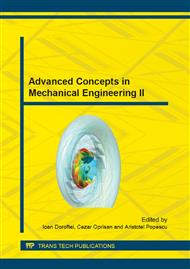p.189
p.195
p.201
p.205
p.211
p.217
p.223
p.231
p.237
Experimental and Theoretical Aspects of Fuelling a Diesel Engine with Liquefied Petroleum Gases
Abstract:
The severe legislation regarding pollution from actual time determine us to find new alternative solutions for diesel engine fuelling. This paper objective is the use of LPG as alternative fuel at a diesel engine in the purpose of pollutant emissions level decreasing in general and especially of NOx and smoke emissions. Is difficult to use LPG as single fuel at the diesel engine because it has an high auto ignition endurance (CN = -3). There are many fuelling methods of the diesel engine with LPG, but the authors of this paper used the diesel-gas method for a 1,5 l engine fuelling. The research followed the establishment of the optimal LPG cyclic dose and the diesel engine adjustments for different engine operating regimen. The paper presents results of some theoretical and experimental investigations of the LPG fuelled diesel engine. Three substitute ratios of diesel fuel with LPG were taken into account for full load and 2000 rpm engine speed. Thus, the NOx emissions decreased with 20-28 % for different substitute ratios of diesel fuel with LPG. The smoke emission decreased with 35-47% for same substitute ratios. LPG fuelling represents a very good solution for a cleaner environment.
Info:
Periodical:
Pages:
211-216
Citation:
Online since:
October 2014
Keywords:
Price:
Сopyright:
© 2014 Trans Tech Publications Ltd. All Rights Reserved
Share:
Citation:


